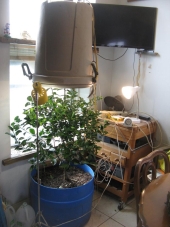
 4
4




 4
4









 4
4





 3
3









 4
4






 1
1









James Colbert wrote:If Holzer can grow lemons in the mountains of Germany you can grow citrus in zone 7 or 8. You may have to make some tweaks to make it work but it can be done successfully long term. In his new book Sepp has an entire section on protecting frost sensitive plants one of the tips he mentions is protecting cold sensitive plants from morning sun as the rapid warming can cause damage to plant tissues. Also don't forget to mulch deeply.




Medicinal herbs, kitchen herbs, perennial edibles and berries: https://mountainherbs.net/ grown in the Blue Mountains, Australia





Angelika Maier wrote:There is a difference between hardiness and that the tree is able to ripen the fruit. For example grapefruit grow where I live but taste much like lemons.
You could try Australian native citrus too, they seem to be pretty hardy. Kumquat is the most cold hardy citrus.
 1
1




Medicinal herbs, kitchen herbs, perennial edibles and berries: https://mountainherbs.net/ grown in the Blue Mountains, Australia

 2
2








 2
2





Ajila Ama Farm Western North Carolina
www.facebook.com/ajilaama
 3
3





 2
2




M Foti wrote:a little off topic but we live even further north in western n.c. and we get below zero quite a bit. there are "feral" citrus trees around here, my father said they were Ponsirus Trifolia (don't know if I spelled that right), they're similar to the filippino "calamunzi", sort of like lemons but smaller. They're quite strong, not really great for straight up eating but make awesome lemonade or additions to meals. I would suspect these critters would be fine for growing just about anywhere in the mid-south.
I don't know their common name, but was quite shocked to find them growing out in the wild. Word of advice though, they have HUGE thorns
 2
2








Cris Bessette wrote:
M Foti wrote:a little off topic but we live even further north in western n.c. and we get below zero quite a bit. there are "feral" citrus trees around here, my father said they were Ponsirus Trifolia (don't know if I spelled that right), they're similar to the filippino "calamunzi", sort of like lemons but smaller. They're quite strong, not really great for straight up eating but make awesome lemonade or additions to meals. I would suspect these critters would be fine for growing just about anywhere in the mid-south.
I don't know their common name, but was quite shocked to find them growing out in the wild. Word of advice though, they have HUGE thorns
Common names I've seen: Bitter orange, Chinese / Japanese bitter orange, Trifoliate orange, target practice orange...
Hey, I work in WNC (Franklin) . Across the border in Georgia where I live there is one large poncirus trifoliata in the middle of town that has fruit every year. I've never seen any in the wild though. I think these are really cool plants. I've started over 20 on my 2 acre property, most of them as a fence.
The thorns are truly horrific, so they great for a natural fence. The trees have a really interesting look year round.
The flavor of the fruit is sour and bitter, with a pine resin aftertaste.
I have a calamondin (calamunzi) tree in a pot, and as sour as those fruit are, they taste 100 times better than PT fruit!
I planted a citrangequat tree in my yard a few years ago, these are a cross between a PT and a sweet orange, (citrange) which was then crossed with a kumquat.
These are supposed to be one of the closest things to a very hardy citrus that can take temps in the teens (F) and make decent useable fruit.
 not far at all. My g/f is filippina and her late mother used to grow calamunzi. She mainly grew them as a joke I think, but we hit it off right away when I liked them and ate them like fruit haha. The trifoliate that is growing over here "wild" has fruit that are actually quite good, the skin does have that piney smell to it, but the fruit doesn't seem to possess it. I've not detected any bitter notes either, but we all know we can get variance depending on many factors. I've tried starting some from seed off of this tree, but not been very lucky yet, I may try to root a cutting this spring. I think it would be nifty to have around. We do have some Calamunzi growing in our home, but they do not get adequate light to flower or fruit. The calamunzi did quite well in eastern n.c. growing inside a little sunroom attached to the in-law's house.
not far at all. My g/f is filippina and her late mother used to grow calamunzi. She mainly grew them as a joke I think, but we hit it off right away when I liked them and ate them like fruit haha. The trifoliate that is growing over here "wild" has fruit that are actually quite good, the skin does have that piney smell to it, but the fruit doesn't seem to possess it. I've not detected any bitter notes either, but we all know we can get variance depending on many factors. I've tried starting some from seed off of this tree, but not been very lucky yet, I may try to root a cutting this spring. I think it would be nifty to have around. We do have some Calamunzi growing in our home, but they do not get adequate light to flower or fruit. The calamunzi did quite well in eastern n.c. growing inside a little sunroom attached to the in-law's house.Ajila Ama Farm Western North Carolina
www.facebook.com/ajilaama




Outdoor and Ecological articles (sporadic Mondays) at http://blog.dxlogan.com/ and my main site is found at http://www.dxlogan.com/





M Foti wrote:
........
franklin is about half an hour east of usnot far at all. My g/f is filippina and her late mother used to grow calamunzi. She mainly grew them as a joke I think, but we hit it off right away when I liked them and ate them like fruit haha. The trifoliate that is growing over here "wild" has fruit that are actually quite good, the skin does have that piney smell to it, but the fruit doesn't seem to possess it. I've not detected any bitter notes either, but we all know we can get variance depending on many factors. I've tried starting some from seed off of this tree, but not been very lucky yet, I may try to root a cutting this spring. I think it would be nifty to have around. We do have some Calamunzi growing in our home, but they do not get adequate light to flower or fruit. The calamunzi did quite well in eastern n.c. growing inside a little sunroom attached to the in-law's house.





D. Logan wrote:I know they aren't technically in the same family as typical citrus, but I wonder if anyone has tried to cultivate a cross between Trifoliate orange and a more tame citrus to make something that is cold hardy and able to be eaten out of hand. It isn't impossible to create a hybrid across such gaps. As I recall the Shipova is one such fruit that was a cross between two genera. It could be a worthwhile project if you could keep the less hardy plants alive long enough to make the attempt.
 )
)




Pecan Media: food forestry and forest garden ebooks
Now available: The Native Persimmon (centennial edition)
 2
2





Pecan Media: food forestry and forest garden ebooks
Now available: The Native Persimmon (centennial edition)





Dan Boone wrote:Chris Bessette's link from 2013 has gone to the great 404 in the sky. So I went and found an Internet Archive version of the link:
https://web.archive.org/web/20141007155939/http://users.kymp.net/citruspages/trifoliates.html






Dan Boone wrote:I started last year with planting some trifoliate oranges from local seeds. Several of the better seedlings look to be coming through the winter in very good shape so I'm hopeful of getting them big enough to transplant out with critter protection before next winter.
I am very interested in several of the cold-hardy crosses. I want to establish trees from the varieties that can survive in this zone, in hopes that even the ones that won't normally make fruit might do so in an unusual year. Global climate change is a wild card but I'm trying to make it work for me!




Pecan Media: food forestry and forest garden ebooks
Now available: The Native Persimmon (centennial edition)





Dan Boone wrote: Doh! I never thought to look for an updated link. Thanks for posting it.
I think kumquat is going to be the next thing I try. I don't have a decent greenhouse situation or any great way to protect trees very much, so I'm going to focus on stuff that "ought" to survive the local conditions.
 2
2








 1
1




yet another victim of Obsessive Weeding Disorder





 1
1




Rez Zircon wrote:I've seen lemons grown from seed (random grocery lemons) survive Montana winters. I've heard of one that bore lots of fruit, growing unprotected at that, in Bozeman MT where winter temps routinely hit -30. An orange-grower friend tells me the trick to hardy citrus is own-root, not grafted stock.
 2
2




yet another victim of Obsessive Weeding Disorder













Francesco Delvillani wrote:Try also Citrangenquat "Thomasville"....very cold-hardy, the unripe fruit is more or less like a Lime, when ripen, instead, is sweet


yet another victim of Obsessive Weeding Disorder










|
Right! We're on it! Let's get to work tiny ad!
The new permaculture playing cards kickstarter is now live!
https://www.kickstarter.com/projects/paulwheaton/garden-cards
|






